
The Half-and-winged order, which people used to call bedbugs, is very numerous and many-sided. Different types of bedbugs, known today to entomologists, sometimes differ so much from each other in appearance, food preferences and lifestyle that a non-specialist can hardly consider them relatives.
You can meet bugs everywhere: in the fields and in flower beds, on land and in the sea, some families have settled in the tropics, others have learned to endure the harsh Siberian winters. Some prefer vegetable food, others prey on their own kind, and others prefer real bloodsuckers.
There are also varieties of bedbugs that are too much attached to people. They appreciate the comfort of human buildings and for a mile away they feel the warmth of their victim. Together with their source of food, bugs are able to travel the world, so they may even end up in the Arctic.
Let's take a closer look at the different species and varieties of bedbugs, as well as see how they look in the photo.
Farmland pests
Oh, they do not like gardeners and gardeners of bugs. After all, many of them are destroying landings, so tenderly preserved by man.
Each mistress knows in the face of the destroyers of their own crops. It can often be found in the cabbage beds. He is visible from afar in his red and black outfit, for good reason they call him painted (see photo):
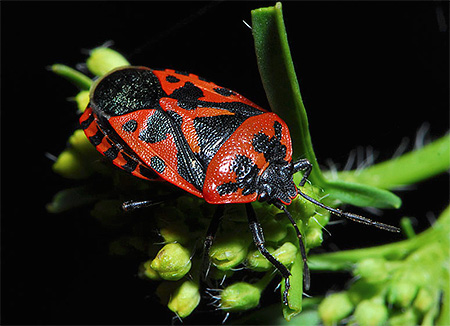
His partner, the Rape bug, glistens with a blue-green back with spots and stripes of white or red color (however, his color is changeable):
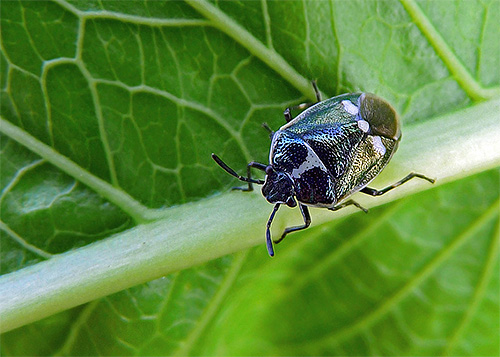
The bright, causing coloring is characteristic for many species of bugs. It serves as a kind of defense against natural enemies, they say, what a terrible thing I am.
Bedbugs in case of danger and another argument to use - an unpleasant smell. Special glands, which are present in most of the Hibetaridae, produce a substance called cimicin acid. It also provides the fragrance for bedbugs, because of which people do not like them very much, and birds do not seek to peck at them.
These insects are not accidentally united into one group of Cruciferous bugs,because it is the plants from the family with the same name that are most often exposed to the onset of such pests - radish and turnip, rape and cabbage. Adults and larvae feed on the sap of the plant, damaging its delicate skin. Yellowish specks remain on the leaves - traces of insects' meal. Loose seedlings after such injuries may die.
Light green shivnik (Palomena Prasina). This type of bug can be recognized by its greenish-yellow color, oval shape, slightly narrowed posteriorly and characteristic protrusions on both sides of the body. They serve as a sign of the belonging of the bug to the family of shushnikov. By autumn, the color of the insect miraculously changes to brown. It can be found in the garden, it feeds on the juices of raspberry and gooseberry, but does not hesitate and cereal crops. This bug can spoil the impression to children who decide to feast on berries. Below are his photo:
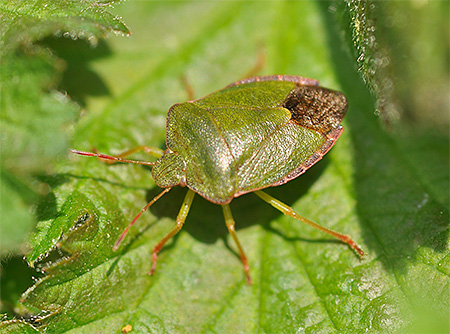
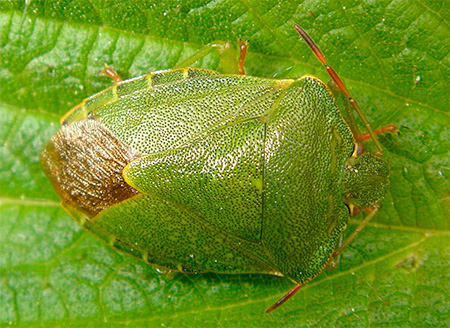
The bug bug (Eurygaster integriceps) is a gray nondescript creature, as can be seen by looking at the photos of this type of bugs:
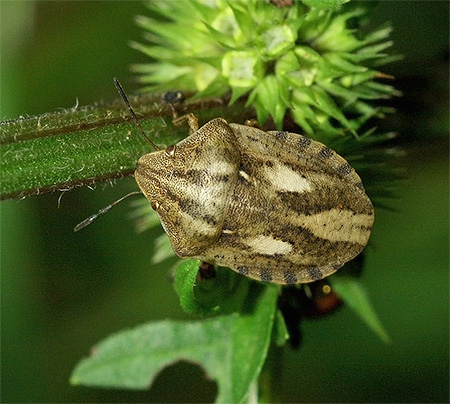
After wintering in the fallen leaves, the starving insects are violently pulling juices from the young shoots of grass crops, and the larvae emerge from the eggs by the time the ear is poured and damage it. Grains become unsuitable for making flour and lose their germination.
The turtles, together with the Breadfruit from the family of the Gopees and the bugs of other species, have ravaged more than one grain field. It is unlikely that someone will burn with love for such animals. So the owners of the estates endure their hatred for all the other varieties of bedbugs, even completely innocent
But it turns out that a disgusting smell does not always help the bugs to avoid retribution. Each chicken, released for a walk around the field, is capable of destroying up to one and a half thousand harmful turtles per day.
Harmless bugs
War paint of some species of bugs fulfills its purpose - they are wary. Take a look at the photo below. This is the Linear Bug (Graphosoma lineatum), sometimes it is called Italian, either in honor of the locality where it was first discovered, or because of its similarity to the form of the Pope's Guardsmen:

Having met such a handsome man in his garden, many would seriously be afraid, having taken him for the Colorado potato beetle, which has undergone a mutation. But in reality, minke whales cannot bring much harm to the garden and garden; they prefer umbrella plants.
Even in the years of their mass reproduction, it is rather easy to cope with them - it is enough to assemble them manually.They usually spend the mating period when they are going to be a company, so it’s easier for them to find a soul mate.
And who has not seen how entire groups of soldiers accumulate on stumps or under the roots of trees? The scientific name of this species of bugs is Red-winged wingless (Pyrrhocoris apterus). And their photos are shown below:
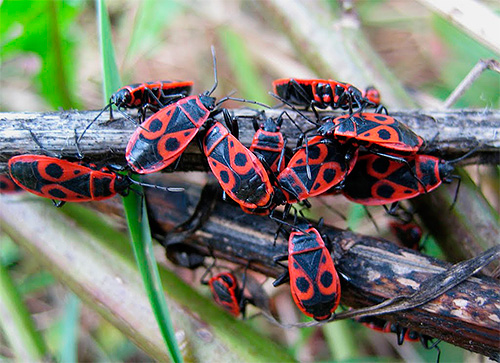
These insects known from childhood are quite common, feeding on fallen seeds and the remains of dead invertebrates.
Alderbird chick (Elasmucha fieber) is a typical member of the family Tree shields. Having recovered from hibernation, by the beginning of summer this unusual species of bugs enters the breeding season:
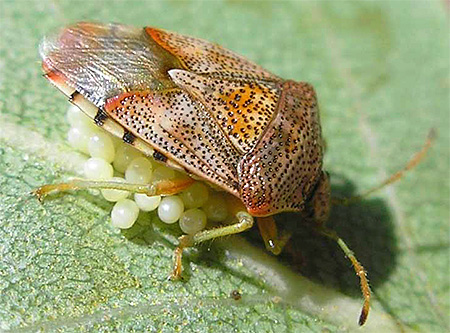
Alder bug females firmly settle on the leaves of alder, currant or birch. There they spend quite a lot of time, first they lay laid eggs, then nurse with the hatched larvae. The spikefish does not depart from its offspring until the babies become active enough and leave the native nest themselves.
Bedbugs - conquerors of the water element
On the water surface of ponds or lakes, you can see a slender and brisk insect with a thin body on high, widely spaced legs:

Oddly enough, and this representative of the family of Hemiptera - Waterman common (Gerris lacustris). Some kind of invisible force holds it on the surface of the water.
Her paws are abundantly covered with small hairs, they never become wet, due to the fatty grease covering the hairs. The bedbug quickly slides through the water and sucks the sap from insects gazing in and falling into the water. For the winter, the water strider, limping, leaves the reservoir and takes refuge in the fallen leaves.
No less interesting is another species of waterbugs living in the aquatic environment - the Water Scorpion (Nepa cinerea):
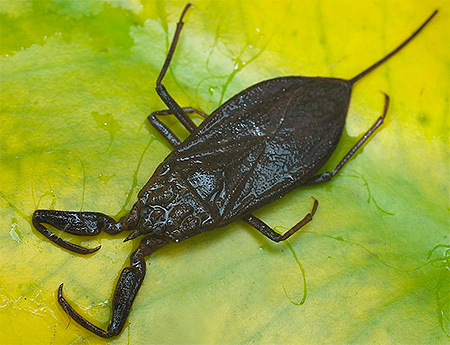
His appearance fully justifies the name. The forelegs, more like claws, serve to grip the victim, and there is a long, needle-like protuberance at the back. The bug bugs in shallow water, because it does not know how to swim at all, hides in algae, crawls along the bottom in anticipation of the victim, putting the tail process above the water, it serves as a device for breathing.
There are among the bugs and these swimmers. In the photo you can see one of them:
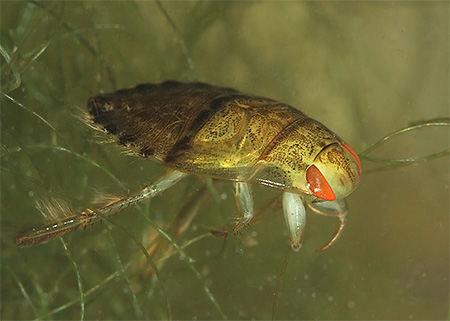
This is Plauthead (Hiocoris cimicoides). It has a dark green with an olive tinge, a powerful body, paws shaped like oars and densely covered with hairs.This species of bugs prey on the larvae of insects, fry and mollusks and spends this activity practically all day.
Bed bugs - parasites
Unfortunately, there are very unpleasant species for a human in the Bug squad. They trade by sucking blood in humans and warm-blooded animals. As soon as the insect is not called, shown in the photo:
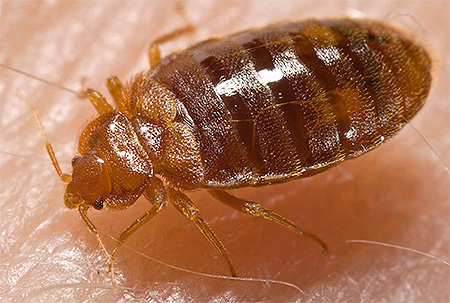
Bedbug, he is home or linen. Biologists classify it as Cimex lectularius. A flat, wingless creature with a keen sense of smell, capable of changing size and color, being saturated with blood. In general, the family has more than 70 species of bed bugs.
His closest relative is the Burning Bug, or Cimex Hemipterus:
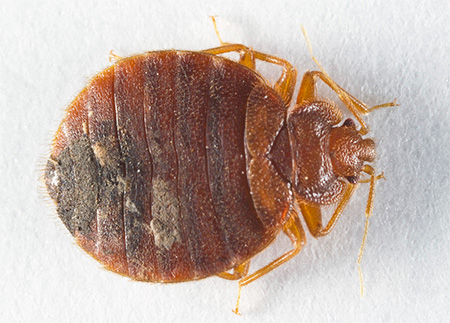
Outwardly, very little differs from a fellow, but a number of features allowed the scientists to single out it into a separate form. It moves more slowly, slightly bouncing, does not tolerate the cold, and therefore it is distributed exclusively in countries with hot climates, and if it is accidentally imported into northern latitudes, it does not survive there for a long time.
The bites of the burning bug are more palpable: it is a pronounced allergic reaction like urticaria, severe itching, often blisters reaching 5 cm.
But the most dangerous for people representative of the order of the Coleoptera lives in Latin America:

Triatomid bugs from the family of predators are nocturnal and often attack sleeping people. Their bite provokes an allergic reaction of varying severity: from slight irritation to anaphylactic shock.
But this is not all the evil he is capable of. Insects are carriers of a deadly disease caused by protozoa, trypanosomiasis, otherwise Chagas disease. For this, the Triatame bug bites have been called deadly kisses.
And the bug can benefit
Man used to think rationally and assess the surrounding fauna, based on the benefits that it brings to him. Farmland pests and ectoparasites are perceived as aggressors, ruthless struggle is being waged with them. But often help comes from the side from which you least expect it.
Potatoes are considered the second bread. What tricks people don’t go to to save the coveted roots from the Colorado potato beetle. But they have allies in this fight.
Zikron blue, species of predator bugs come from England.Insect bluish-green with metallic luster, able to hunt only in the daytime due to the fact that at night it simply does not see. Zikron eats eggs or small larvae of leaf beetles.
Another fighter belongs to the Perillus genus - Perillus bioculatus .:
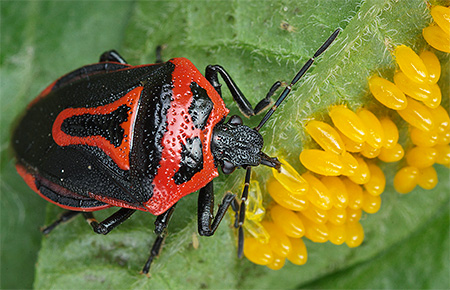
It is noticed that he manages to cope even with the imago. So far, bugs cannot compete with insecticides, but scientists are actively exploring the use of entomophages in the battle to preserve the crop.
The fauna of tropical countries is interesting and unusual for the eyes of Russians. There are special varieties of bedbugs that affect size, shape and color. You can admire such an unusual creature captured in the photo in the forests of South America:
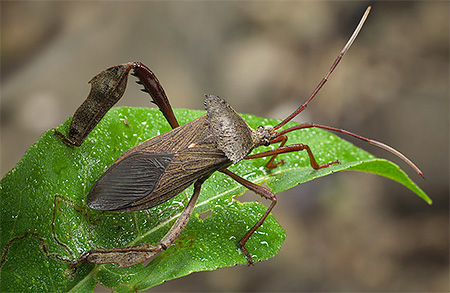
The leaf-legged bug belonging to the family of kraevikov, has unusual extensions on the hind legs, like leaves.
The world of insects is huge, their life, subject to strange instincts and full of miraculous transformations, is of genuine interest. Few people know what beautiful species of bedbugs are found on our planet. People are used to thinking badly about this detachment, but there are truly unique examples in it that can please the eye and surprise.
Firebug: Macro

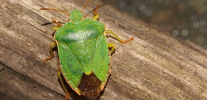
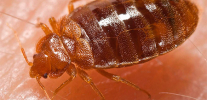

Watched the viburnum and its pest: "The viburnum leaf beetle." There are useful bugs that destroy them quickly, one bug remains from the bug for one or two minutes.